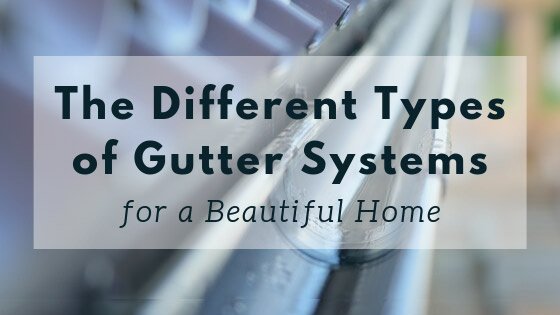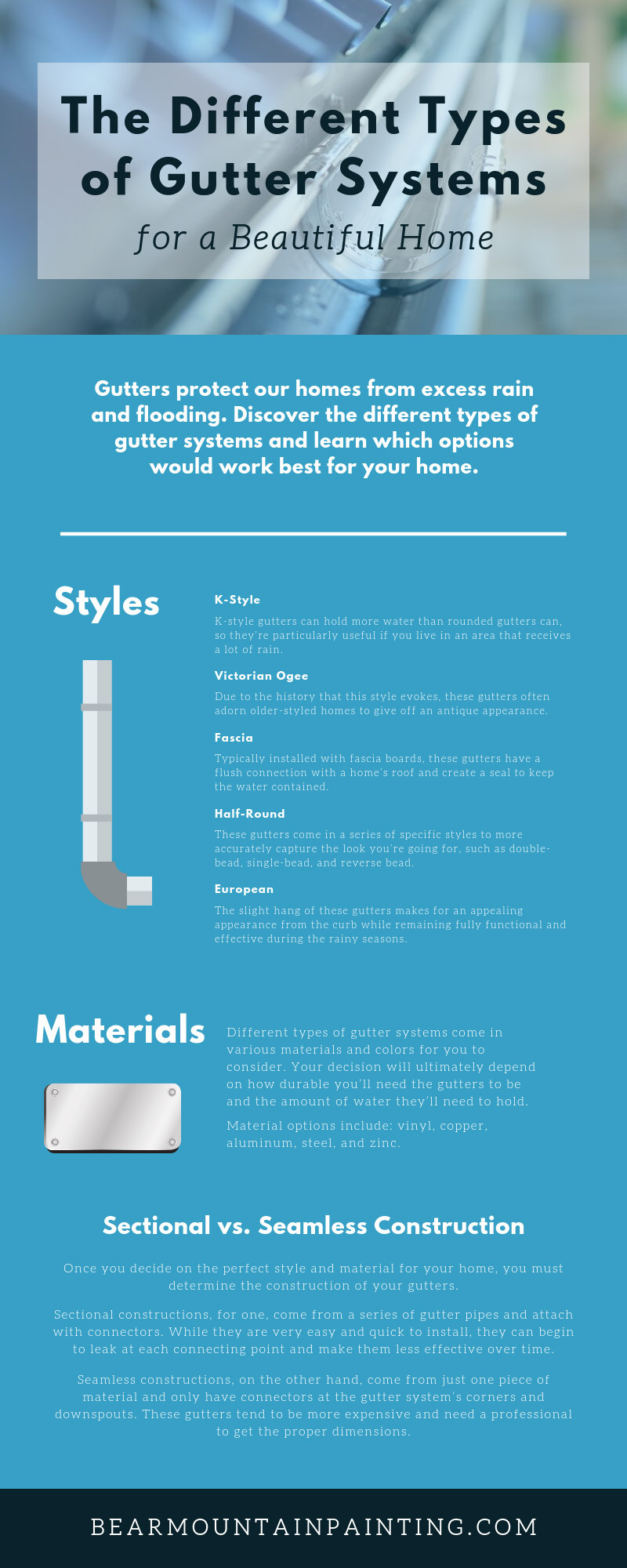Though your gutters may seem like an accessory on your home, they’re extremely important to maintaining the beauty and overall condition of your property. Directing excess rainwater away from your home’s foundation, these seemingly simplistic pipelines protect from flooding and prevent your home’s exterior from becoming ruined. Unfortunately, these pieces don’t last forever, and when they begin to deteriorate, your home can suffer more damage than you’d suspect. When you notice the signs to replace your gutters, check out some of these different types of gutter systems to make the best choice for your home.
Styles
While buying new gutters for your home might not be the most exciting renovation, they come in various styles to fit with a series of designs and colors. When going through your choices, be sure to consider the slope of your roof and how much rain you typically get in your location. These factors will help you determine what you need from your gutter system and leave room for more creativity when you’re choosing the design. With these options available, you’re sure to find what you need to get the job done and meet your styling at the same time.
K-Style
This style is very common due to its popular design and effective shape. K-style gutters can hold more water than rounded gutters can, so they’re particularly useful if you live in an area that receives a lot of rain. Since their decorative outer design is similar to crown moldings, they’re also good at complementing a home’s exterior and adding a bit of extra style.
Victorian Ogee
Victorian ogee gutters, or old gothic gutters as they’re more commonly known, have a distinct design inspired by the styles of 19th-century cast-iron gutters. Due to the history that this style evokes, these gutters often adorn older-styled homes to give off an antique appearance. Keep in mind, however, that Victorian ogee gutters are shallow and can’t hold as much water as other designs.
Fascia
Typically installed with fascia boards, these gutters have a flush connection with a home’s roof and create a seal to keep the water contained. Fascia gutters have a sharp and straight design that almost disguises it as part of the siding. Its ability to camouflage the outer rafters can help prevent water from seeping through the cracks and keep animals from finding a way into your home.
Half-Round
Half-round gutters have a very traditional appearance that works well on homes with a more antique design. They also come in a series of specific styles to more accurately capture the look you’re going for, such as double-bead, single-bead, and reverse bead. These additional styles won’t affect the way that the gutter performs and allow for more flexibility when making your decision.
European
Another subset of half-round gutters, homeowners note this style for the amount of class it can add to a home’s exterior. The slight hang of these gutters makes for an appealing appearance from the curb while remaining fully functional and effective during the rainy seasons.
Materials
In addition to the several gutter styles, different types of gutter systems come in various materials and colors for you to consider. Your decision will ultimately depend on how durable you’ll need the gutters to be and the amount of water they’ll need to hold. The materials you choose should be able to stand up to the elements and be strong enough to last for several years.
Vinyl
If you live in an area with frequent and heavy storms, vinyl gutters are an effective option to keep your home looking nice. Plus, it will prevent frequent gutter replacements. Since they’re made from strong and sturdy plastic, vinyl gutters are resistant to bending, denting, and corrosion from the elements. However, because they’re cheap and lightweight, it’s important to research which ones you want to ensure their quality.
Copper
Copper, aside from offering a beautiful color to your design, is also resistant to mold, mildew, and rust growth. This means that you won’t need to worry about conducting regular maintenance. This material also reacts to the elements and creates a desirable aging effect over time. Keep in mind that while copper gutters are a worthwhile investment, they tend to be higher in price and require a professional to install them correctly.
Aluminum
Aluminum is the most common gutter material used on homes across the country. Like vinyl, this material is incredibly lightweight and easy to install. Homeowners can also paint aluminum to match the pre-existing color scheme—they’re a perfect addition to any home. However, this material is more prone to denting and bending under prolonged stress so they may require some maintenance.
Steel
Steel gutters are extremely strong and come in a series of color options for you to choose from. Different models are available to help you find the right fit for your home. These models include stainless steel, galvanized steel, and galvalume steel. Each contains their own mix of metals and treatments to resist certain elements and slow down the rusting process.
Zinc
Zinc is a durable and long-lasting material that commonly appears on higher-end residences. They often require professional installation as contractors need to weld the joints together. But, like copper, zinc will weather and add character with a patina color scheme.
Sectional vs. Seamless Construction
Once you decide on the perfect style and material for your home, you must determine the construction of your gutters. While this doesn’t change how the gutters work, different constructions offer additional benefits and drawbacks when placed on certain houses.
Sectional constructions, for one, come from a series of gutter pipes and attach with connectors. This gives you the ability to properly measure and fit your home with the perfect-sized models. While they are very easy and quick to install, they can begin to leak at each connecting point and make them less effective over time.
Seamless constructions, on the other hand, come from just one piece of material and only have connectors at the gutter system’s corners and downspouts. This is typically the method used when building gutters with stronger materials such as steel and zinc. However, these gutters tend to be more expensive and need a professional to get the proper dimensions.
No matter the type of gutters you ultimately decide on, it’s important that you have them installed by qualified professionals to get the best results. We can provide you with those very resources at Bear Mountain Custom Painting. Our gutter installation services in Cumming, Georgia, can take the worry out of your gutter renovations and leave you at ease with quality, lasting results.






